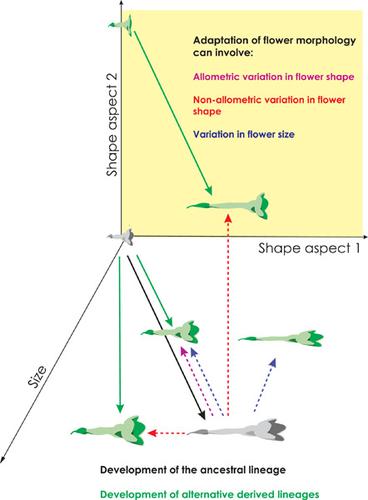当前位置:
X-MOL 学术
›
Evol. Dev.
›
论文详情
Our official English website, www.x-mol.net, welcomes your
feedback! (Note: you will need to create a separate account there.)
The role of ontogenetic allometry and nonallometric flower shape variation in species‐level adaptive diversification – Calceolaria polyrhiza (Calceolariaceae) as a case study
Evolution and Development ( IF 2.6 ) Pub Date : 2020-12-29 , DOI: 10.1111/ede.12363 Marina M Strelin 1 , Andrea Cosacov 2 , Vanina R Chalcoff 1 , Constanza C Maubecin 2 , Alicia N Sérsic 2 , Santiago M Benitez-Vieyra 2
Evolution and Development ( IF 2.6 ) Pub Date : 2020-12-29 , DOI: 10.1111/ede.12363 Marina M Strelin 1 , Andrea Cosacov 2 , Vanina R Chalcoff 1 , Constanza C Maubecin 2 , Alicia N Sérsic 2 , Santiago M Benitez-Vieyra 2
Affiliation

|
Organism shape changes predictably during ontogeny, resulting in specific patterns of ontogenetic allometry. In several plant and animal lineages, among‐species variation in the shape of mature organisms mirrors variation along their growth trajectories. Hence, ontogenetic allometry is an important bias in evolution. This bias should be stronger at reduced evolutionary time scales, in which among‐trait correlations had less time to evolve. Nevertheless, it was shown that adaptation of organism shape frequently involved departures from the ancestral ontogenetic allometry. Moreover, only a moderate fraction of shape variation is correlated with size during ontogeny. Hence, nonallometric variation in shape (NAVSh) is likely to contribute to adaptation, even at reduced evolutionary time scales. We explored the contributions of allometric variation in shape (AVSh), NAVSh, and size variation to adaptive evolution in the angiosperm species Calceolaria polyrhiza. This strongly relies on oil‐collecting bees for pollination and experienced transitions in the size of pollinators during the last 2 Ma. Using geometric morphometrics, we described corolla morphology in several populations across its distribution range. Variation in corolla shape was decomposed into an allometric and a nonallometric component, and corolla size was estimated. We then looked for the correlation between these aspects of morphology and the pollinator. Our results suggest that adaptation to pollinators with different sizes relied on NAVSh, which resulted from shifts in the allometric slope and from shape changes that occurred early in flower development. We conclude that NAVSh can contribute to adaptation in flowering plants, even at the species‐level.
中文翻译:

个体异速生长和非异速生长花形变异在物种水平适应性多样化中的作用——以Calceolaria polyrhiza(Calceolariaceae)为例
生物体形状在个体发育过程中发生可预测的变化,导致个体发育异速生长的特定模式。在几个植物和动物谱系中,成熟生物体形状的物种间差异反映了其生长轨迹的变化。因此,个体发育异速生长是进化中的一个重要偏差。这种偏差在进化时间尺度减小时应该更强,其中性状之间的相关性进化的时间更短。然而,研究表明,生物体形状的适应经常涉及背离祖先的个体发育异速生长。此外,在个体发育过程中,只有一小部分形状变化与大小相关。因此,形状的非异速生长变异 (NAVSh) 可能有助于适应,即使在进化时间尺度减小的情况下也是如此。多根黄花菜。这在很大程度上依赖于采油蜜蜂进行授粉,并在过去 2 Ma 期间经历了传粉者大小的转变。使用几何形态计量学,我们描述了分布范围内几个种群的花冠形态。花冠形状的变化被分解为异速生长和非异速生长的成分,并估计了花冠的大小。然后,我们寻找形态学的这些方面与传粉者之间的相关性。我们的研究结果表明,对不同大小的传粉媒介的适应依赖于 NAVsh,这是由于异速生长斜率的变化和花朵发育早期发生的形状变化造成的。我们得出结论,即使在物种水平上,NAVSh 也有助于开花植物的适应。
更新日期:2020-12-29
中文翻译:

个体异速生长和非异速生长花形变异在物种水平适应性多样化中的作用——以Calceolaria polyrhiza(Calceolariaceae)为例
生物体形状在个体发育过程中发生可预测的变化,导致个体发育异速生长的特定模式。在几个植物和动物谱系中,成熟生物体形状的物种间差异反映了其生长轨迹的变化。因此,个体发育异速生长是进化中的一个重要偏差。这种偏差在进化时间尺度减小时应该更强,其中性状之间的相关性进化的时间更短。然而,研究表明,生物体形状的适应经常涉及背离祖先的个体发育异速生长。此外,在个体发育过程中,只有一小部分形状变化与大小相关。因此,形状的非异速生长变异 (NAVSh) 可能有助于适应,即使在进化时间尺度减小的情况下也是如此。多根黄花菜。这在很大程度上依赖于采油蜜蜂进行授粉,并在过去 2 Ma 期间经历了传粉者大小的转变。使用几何形态计量学,我们描述了分布范围内几个种群的花冠形态。花冠形状的变化被分解为异速生长和非异速生长的成分,并估计了花冠的大小。然后,我们寻找形态学的这些方面与传粉者之间的相关性。我们的研究结果表明,对不同大小的传粉媒介的适应依赖于 NAVsh,这是由于异速生长斜率的变化和花朵发育早期发生的形状变化造成的。我们得出结论,即使在物种水平上,NAVSh 也有助于开花植物的适应。











































 京公网安备 11010802027423号
京公网安备 11010802027423号